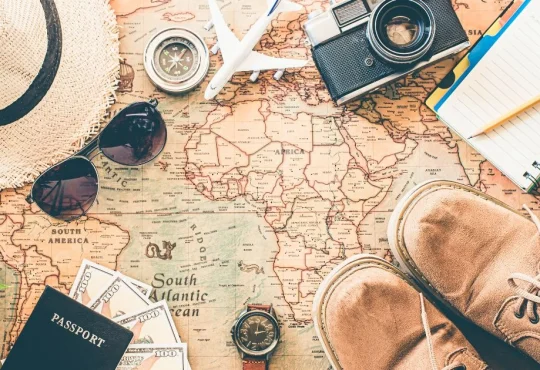Airline travel comes with its share of discomforts, including navigating tight spaces and strict TSA rules. One of the most challenging aspects is using the airplane lavatory, especially when urgent needs coincide with crowded conditions. The confined space and minimal privacy in aircraft bathrooms can amplify these inconveniences, making passengers feel self-conscious about drawing attention. Thankfully, innovative tips from online sources provide discreet strategies for managing mid-flight bathroom visits, offering a more comfortable and inconspicuous experience for travelers.
10 Airplane Bathroom Hacks That Will Transform Your Flight!
Optimize Your Chance for a Bathroom Break While in the Window Seat
When seated at the window during a flight, enjoying the view comes with the challenge of managing bathroom breaks. Unlike aisle passengers who can easily move, those in window seats often need to coordinate with seatmates to access the aisle, disrupting their settled state mid-flight. To minimize these interruptions, experienced travelers recommend timing bathroom visits with those of neighboring passengers. This strategy reduces disruptions and takes advantage of moments when the aisle or middle seat is already vacant, making it easier to exit without hassle.
The advice shared on a Reddit thread dedicated to airplane etiquette emphasizes waiting a brief moment after a neighboring seat has cleared to make a restroom visit discreetly. If the timing doesn’t align with others’ breaks, politely asking seatmates for a moment to pass is perfectly acceptable. Most passengers, especially those in aisle seats, understand the occasional need to move and are generally accommodating to such requests.
Managing bathroom breaks from the window seat requires tactful timing and consideration. Despite initial discomfort about disturbing neighbors, clear communication and thoughtfulness can help ensure a smoother travel experience for everyone on board. By following these tips, travelers can handle restroom visits discreetly and respectfully, maintaining a harmonious environment throughout their flights.
Considerate Aisle Seat Etiquette
Aisle seat passengers can significantly enhance the in-flight experience by considering their neighbors’ comfort, especially regarding bathroom breaks. Taking a moment during boarding to inform adjacent passengers that they needn’t hesitate to ask for passage can alleviate any awkwardness when nature calls. This proactive approach fosters a more relaxed atmosphere, ensuring smoother transitions and less inconvenience for everyone in the row.
“I prefer the aisle seat and often reassure the middle and window passengers not to hesitate in asking me to move,” shared a Reddit user, highlighting the empathy gained from experiencing the window seat’s discomfort. Establishing this understanding upfront minimizes potential anxiety for others and encourages mutual consideration throughout the flight. Such gestures can also prompt reciprocal gestures, like adjusting window shades to reduce glare, further enhancing the travel experience for all involved.
By fostering open communication and empathy, aisle seat passengers can contribute to a more harmonious and considerate atmosphere during flights. Proactively addressing potential inconveniences and respecting fellow passengers’ needs not only eases the logistics of in-flight movement but also promotes a sense of shared understanding and cooperation among travelers.
Use the restroom while passengers are still awake.
To ensure a smoother flight for all, passengers should strategically time their bathroom visits, particularly on long or overnight flights. Using the restroom before neighboring passengers settle in for sleep reduces the likelihood of disrupting them later when accessing the aisle becomes more challenging. Watching for signs like neck pillows or sleep masks can indicate an opportune moment to quietly excuse oneself without disturbing others.
When it’s necessary to wake a sleeping seatmate, it’s important to proceed with tact and sensitivity. Starting with a polite verbal request such as “Excuse me” is typically advisable, though results can vary. If verbal cues aren’t effective, a gentle touch on the arm can gently awaken them without causing alarm. When all else fails, seeking assistance from a flight attendant ensures minimal disturbance to others while facilitating movement within the cabin.
Following these guidelines allows passengers to manage their restroom visits thoughtfully, contributing to a more considerate and enjoyable flight experience for everyone aboard. By planning and respecting fellow travelers’ rest, air travel becomes more comfortable and courteous for all involved.
Avoid climbing over fellow passengers.
If the idea of crawling over a slumbering passenger fills you with dread, you’re not alone in your sentiments. Many travelers have shared their stories online, revealing the perils of attempting such maneuvers mid-flight. While some have managed to navigate this acrobatic feat without incident, likening it to a “regular Spider-Man move,” others haven’t been so fortunate. One traveler recounted a mishap where they nearly toppled over while straddling a sleeping fellow passenger, thankfully without waking them.
In another instance shared on Reddit, a passenger woke up to find someone attempting to climb over them, resulting in an awkward and uncomfortable encounter. Such stories serve as cautionary tales against risking disruptions and discomfort for fellow travelers in the pursuit of restroom access.
Navigating airplane etiquette with respect and consideration is key to maintaining harmony onboard. Whether it’s avoiding intrusive maneuvers or simply being mindful of others’ personal space, ensuring a smooth and respectful travel experience benefits everyone involved.
Wait for the flight attendants to collect the trash
Remember how classrooms often buzzed with energy after lunch? Frequent fliers suggest a similar phenomenon on airplanes, where passengers perk up after meals before settling back down. While this might seem like an ideal time for a restroom break, it often leads to crowded lines at the lavatory due to many others having different ideas.
To avoid inconveniencing fellow passengers, it’s prudent to wait until flight attendants have cleared mealtime trash and restored tray tables to their upright positions. One traveler on Reddit shared a frustrating experience: “I had this happen to me recently (literally as soon as we got our drinks and I had to juggle a bunch of open cups) and did not appreciate it.” Another seasoned red-eye traveler agreed, noting, “Not only is it a pain for people to move all that stuff, but there’s usually a cart in the aisle to contend with as well.”
By timing restroom breaks strategically after meal services and ensuring minimal disruption to aisle traffic, passengers can navigate these situations more smoothly and considerately.
Maximize Bathroom Efficiency
To make things smoother for everyone and minimize disruptions, it’s wise to consolidate your movements whenever possible while on a flight. As advised by a Reddit user, multitask by attending to all your needs in one go—whether it’s a bathroom break or accessing your overhead locker. This approach not only reduces the frequency of getting up but also keeps the aisle clear for other passengers.
Once inside the lavatory, efficiency is key. Avoid lingering unnecessarily and stow away distractions like your phone to focus on a quick and efficient restroom visit. An etiquette-savvy commenter from the discussion recommends being mindful of any waiting passengers. While it’s tempting to freshen up during a redeye flight, remember to be considerate of others who are also in need.
Moreover, resist the urge to socialize or congregate in the aisle near the restroom. Lingering in the aisle can obstruct the flow of traffic and inconvenience fellow passengers. Keeping these considerations in mind ensures a smoother and more respectful experience for everyone onboard.
Limit Your Liquid Intake
Combatting boredom on long flights can lead travelers to consume excessive liquids like coffee, soda, or alcohol, inadvertently causing frequent bathroom breaks. To mitigate this, a Reddit user advises opting for less hydrating alcoholic drinks such as wine or liquor instead of beer, which can necessitate more frequent restroom visits. They caution against consuming multiple beers due to the need to get up every 30 minutes, which can be disruptive.
Given the dry air in airplane cabins, it’s wise to moderate liquid intake. Overconsumption of alcohol or caffeine can lead to dehydration and discomfort during the flight. Therefore, prioritizing balanced hydration with water helps prevent excessive fluid intake that may increase the need for bathroom breaks.
By being mindful of what and how much you drink, you can minimize disruptions and ensure comfort throughout your flight. This approach allows you to manage your body’s hydration needs effectively while airborne.
Inform Your Seatmates if You Feel Air Sick
Informing your seatmates about air sickness before it becomes an issue can greatly mitigate potential disruptions during your flight. By preemptively letting those around you know about your condition, especially when seated at the window, you can ensure they are prepared for any urgent needs you may have. This proactive communication helps maintain a considerate and understanding atmosphere onboard.
Being prepared is essential in managing air sickness episodes effectively. A shared experience on Reddit highlighted the impact of unexpected illness on a Southwest flight, where a passenger’s discomfort affected the entire cabin environment. This underscores the importance of proactive communication to minimize inconvenience for both yourself and fellow travelers.
Flight crews are usually accommodating and can assist passengers experiencing air sickness by arranging seating closer to restrooms or providing additional support as needed. Sharing experiences like one traveler’s adjustment to seating after experiencing food poisoning on a flight from Barcelona to Moscow illustrates how airlines can respond to health-related issues during travel.
Verify if the restroom is in use before pulling the door
Few things are more awkward than hastily pulling on the airplane lavatory door handle without first checking the “Occupied” sign. If someone is inside, you risk startling them and disrupting their privacy. As one frustrated Redditor vented in a r/Rant post, “I hate being in the middle of my peaceful bathroom break, only to jump because someone jiggled the door handle and tried to force the door open.”
Develop the habit of pausing to glance at the door sign before attempting to open it. A Reddit user emphasized the importance of this in bathroom etiquette, noting, “Too many people rush down the aisle and try to pull open the door when the ‘Occupied’ sign is clearly lit. Many seem unaware that they can see the sign from their seat.”
And then there’s the worst-case scenario: accidentally opening the door on someone who forgot to lock it, leading to mutual embarrassment. Even if the bathroom appears empty, it’s prudent to knock gently and open the door slowly to avoid such awkward encounters. After all, nobody wants to find themselves unexpectedly face-to-face with a fellow passenger in a compromising moment aboard a plane.
Sit Down for a Smoother Experience
People who typically stand while urinating are doing a favor to everyone else by opting to sit during flights. This adjustment is due to the challenges of maintaining aim in the shaky environment of airplanes, even in relatively calm conditions. According to a study from Brigham Young University cited by Stuff, men often experience more splashback than they realize, regardless of their confidence in their aim. Factors such as alcohol consumption, age, and prostate issues exacerbate this.
Sitting down is not only courteous to fellow passengers but also promotes better health outcomes. Research sponsored by Leiden University Medical Center indicates that male passengers who sit not only reduce their restroom time but also achieve more complete bladder emptying. Concerns about masculinity should be tempered by the understanding that standing to urinate is primarily a Western cultural norm. Ultimately, adopting sitting as the norm in-flight benefits everyone without compromising personal dignity.
Conclusion:
Navigating airplane bathrooms can be made smoother with strategic planning and thoughtful communication. Whether timing restroom breaks to minimize disruptions or informing seatmates about personal needs like air sickness, these strategies enhance comfort and respect for fellow passengers. By adopting these ninja-like hacks, travelers can transform their flight experience into a more harmonious journey. These tips not only optimize personal comfort but also contribute to a considerate and enjoyable atmosphere onboard, ensuring a smoother and more pleasant air travel experience for all.





